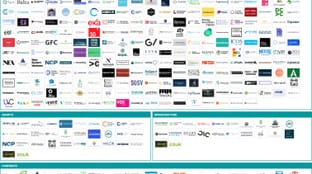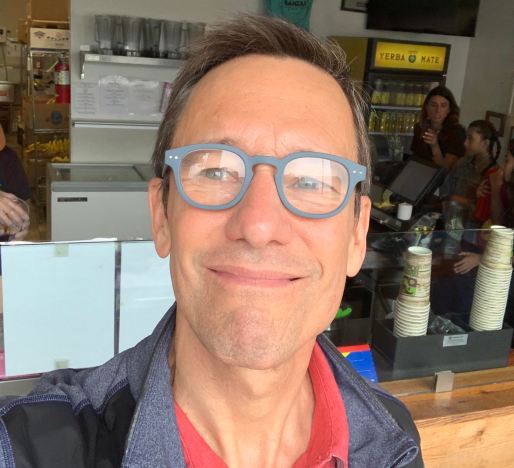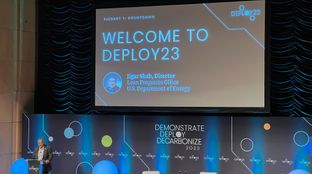
🌏 Who are the Climate Tech Investors?
A new interactive Climate Capital Stack Map
We sat down with Mark Tercek, former longterm CEO of The Nature Conservancy and managing director at Goldman Sachs.

We sat down with Mark Tercek, former longterm CEO of The Nature Conservancy and managing director at Goldman Sachs. He currently advises companies, investors, and NGOs on environmental and organizational strategies. Mark is a global leader in conservation finance, corporate sustainability, and cross-sector collaboration. He champions the idea of natural capital – placing a value on nature for its intrinsic benefit as well as its ecosystem services, such as clean air and water, productive soils, and a stable climate.
You have an interesting background — starting as a partner and managing director at Goldman Sachs and then becoming CEO of The Nature Conservancy. Can you tell us about your decision to focus on climate?
I grew up in Cleveland and have been an urbanite my entire life. When my wife and I were raising our kids, we wanted them to have greater exposure to nature than we had growing up. From some excursions, I realized there was an inner environmentalist in me. I believe that people innately care about nature so once they’re exposed to it, either in their backyard or across the globe, they’ll catch the nature bug like I did and come to more highly value and respect our planet.
Throughout my time at Goldman Sachs (GS), I believed business could be a force for good. My goal has always been to use business to address environmental challenges. Back then, I spoke to my boss, Hank Paulson (later Secretary of Treasury under President Bush), and Hank suggested that I build an environmental initiative at Goldman. So, I started a small team with the intention of baking an environmental strategy into every division at GS. The strategies had to (1) make money and (2) have positive, quantifiable environmental outcomes. It took off — if we found environmental shortcomings in our due diligence, we would turn down a business unless they improved.
One day, a headhunter at The Nature Conservancy called and asked if I knew any CEO candidates. I said I have one: me. Luckily, my recommendation worked out. While I was at TNC, we had a great run thanks to the organization’s great team. We almost tripled in size, launched a tech accelerator, an impact investing unit (“Naturevest”), started an urban conservation program and some very effective new science initiatives, and completed a $7 billion capital campaign. We did everything we could to grow support for environmental progress (through people, political clout, and money). Now, I’m trying to draw on those two experiences from finance and the nonprofit world to accelerate environmental progress as an advisor to companies, funds, NGOs, and foundations.
What types of projects are you focused on now?
I consider myself a full-time environmentalist. My strategy is to find influential CEOs, investment fund executives, or nonprofit leaders who are ambitious about addressing environmental challenges. Traditional consulting models tend to focus on the past, but it’s clear to me that the big opportunities of the future are going to be driven by entirely new innovations. When I show up, I push CEOs to be bolder. I’m here to push them to distinguish themselves as business leaders over the next 10 years through breakthrough opportunities in climate change or other environmental challenges.
At the end of the day, I’m driven by trying to maximize the positive environmental impact I can achieve. My generation screwed up, but maybe we can make amends and achieve some progress before it’s too late. The current generation —like you, the editors of this newsletter— will be the ones carrying the ball forward.
Out of the various climate issues, why focus on conservation and nature-based solutions?
First, I ran The Nature Conservancy, the world’s largest nature conservation organization. There’s so much nature that needs protection and is vitally important, yet there aren’t enough resources (money or people) on our side. I wrote a book about investing in nature to restore forests, take better care of soils, and improve mangroves and grasslands. Out of these ecosystem services, we get biodiversity and environmental benefits like water filtration and carbon sequestration. Human communities all around the world benefit from and depend on all of this too of course. Nature provides a huge amount of undervalued resources. I like to say “Nature is our best investment opportunity.”
Second, it’s increasingly clear that we can’t meet our climate goals without carbon removal. I agree that emissions reduction and mitigation are of the utmost importance, but I think that we can chew gum and walk at the same time – investing in nature-based offsets is a complementary strategy. I’m also in favor of technology-based carbon removal, but it doesn’t seem to work just yet. We need to phase out coal, transition to renewables, make buildings more efficient, electrify transportation, and decarbonize industrial fuels. We know what we need to do, and there’s a lot on our plate, so I think there needs to be more open-minded support of all environmental strategies.
For me, I can help bridge the divide between the business and the environmental community and drive greater effectiveness. Companies need to better appreciate the opportunities in nature-based solutions and environmental problem-solving. And NGOs, in my view, can also be partnering more effectively with the private sector. I wrote a recent blog about this.
What are your criteria for determining who to work with and whether companies are serious about climate action?
I choose to work with CEOs who prioritize addressing climate or other environmental challenges. Look, it’s hard to run a company. There are endless competing priorities. There are many well-intended CEOs, but I opt to work with those who are as ambitious as I am and willing to go above and beyond for climate impact.
To be disruptive and achieve big things, companies have to dare to be great and take on some challenges that very well might not pan out. That’s also where some staunch environmentalists sometimes get it wrong. Some enviros, if unsure about the risks of an initiative, will sit on the sidelines and play it safe. I believe in trying to make initiatives succeed, hoping that there will be positive impact along the way, and understanding sometimes it won’t go as planned. We have to do what we can to accelerate environmental progress despite the risk of sometimes failing. As we make more progress, we can keep ratcheting up the bar. But we shouldn’t let “perfect be the enemy of good.”
How can corporations, governments, and individuals be the most effective in addressing climate and environmental issues?
I think we should be careful about overly demonizing companies and people who have historically been climate “bad guys.” To be sure, scrutiny and criticism of bad actors is very important. But I think some former “bad guys” just might be reformed and be able to help the cause in important ways. One such case of how this demonization can slow climate progress shows up in a new and good research report from the Sierra Club and Rocky Mountain Institute. Many coal plants today have long-term power purchase agreements (PPAs). From the utilities’ perspective, these arrangements are reliable and profitable so they’re not incentivized to change them. But we know that they are disastrous on the carbon front. Some emerging private sector players want to buy these coal plants and convert them to wind and solar, but because banks have been persuaded against lending to anything in connection with coal power, it can be difficult to get funding for making this renewables transition. That’s a case where overdoing the demonization of coal is actually slowing climate progress.
This also could happen when we think about the need to develop renewable energy projects around the world. It’s not easy to build big projects in certain geographies due to a long list of challenges ranging from politics to logistics. But who’s effective at doing projects in those areas? The big oil and gas companies. Now that BP and Shell are telling the world they want to be reformed energy companies and better climate citizens, they have the potential to take their extensive international project management expertise and redeploy it into the renewables space. I think we should encourage this.
What do you envision a successful carbon offset market looking like? Who are the suppliers, third party verifiers, and buyers?
First of all, offsets have not worked very well yet, so we should still be cautious. But there’s a lot of promising activity – especially in the corporate space. Companies like Microsoft, the airline industry, and Shell / BP are all pledging to reach carbon neutrality. To go beyond what they’re able to do through emissions reductions, they need to have a complementary offset toolkit. Stripe just bought their first offsets and committed themselves to total transparency. Microsoft, at a larger scale, is doing this too. Their engagement on these matters should help improve the offset market in a significant way. I’m optimistic.
You’re going to see corporate demand scale pretty quickly for high quality offsets. These players are going to want their offsets to be verified by the Verras / Gold Standards of the world, but as all know there are inherent risks including additionality, leakage, and permanence. Add on the complications of climate change itself (for example, fires wiping out forests) and you see that nature-based projects will always be at some risk. As more corporates drive up demand for very high quality offsets, though, we’ll get more clever at addressing such challenges. For example, there’s a company called SilviaTerra that sells a rolling pool of annual forest offsets to address the permanence challenge, which is a good example of a financing innovation to drive down natural offset risks. We also see a number of new companies using technology such as AI to improve monitoring and measurement.
How can organizations and individuals have the most impact?
Pragmatically, organizations should approach environmental impact from an activities basis and think about where it can reduce emissions, create innovations and breakthroughs, and use its clout and influence to lead by example. They should also push very hard for the regulatory policy we need.
On an individual basis, I wrote a recent blog about the 4 main things you can do to have the most climate impact:
1) Get political. Statistics show many young people don’t vote. We need to change that. Beyond voting, we must engage in politics through efforts like Get Out the Vote. There’s nothing more important. Let’s face it, we have – with a few positive exceptions – mostly inadequate (or worse) political leadership on climate.
2) Push your organization to do more. There are opportunities for climate progress within your workplace, school, and community. Look at Amazon as an example. Before the company’s recent climate announcements, employees were rallying internally and succeeded in expediting action. These days, CEOs listen to their employees; university presidents listen to their students; and politicians listen to their constituents. Use your clout, and be thoughtful about speaking up. The goal is to make something happen.
3) Engage with nonprofits. There are many great nonprofits, so pick the one that appeals to you. For every Nature Conservancy there’s a 350.org or Extinction Rebellion. All nonprofits are under-resourced, understaffed, and underfunded. Not to mention that engaging with these groups can bring joy and meaning to your life.
4) Get out into nature. People my age spent three times more time outdoors when they were kids than our busy, tech-enabled, urban young generation. I’m nervous that there will be a generational disconnect to nature. So I always encourage folks to go explore nature to help build a conservation ethic. When you can do so, please take young kids out in nature. I think that a respect and love of nature drives all of the other motivations for impact that we just spoke about.
I’d like to add one more ask of the people reading this. Please try to be kind and find common ground with people who don’t see the world in the same way. This can be hard these days, but I worry that divisiveness, polarization, and harsh partisanship will be a big obstacle to environmental progress. It has taken me a very long time, but in recent years I’ve started to learn that common ground can be found in situations where it seems unlikely. On a personal basis, it feels good to cross divides and make new friends. And if we scale such efforts, we just might build the majority political coalition we need. Let’s face it, we’re all in this together. Let’s try to act that way.
Interested in more content like this? Subscribe to our weekly newsletter on Climate Tech below!

A new interactive Climate Capital Stack Map

Financing around first- or early-of-a-kind project risk

‘Government-enabled, private sector-led’ in action in Washington, DC